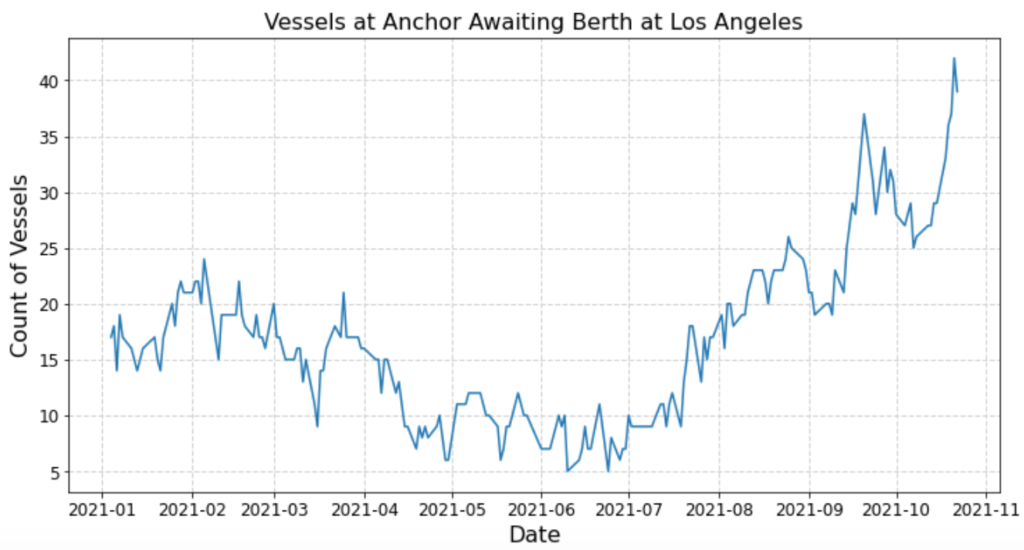The trend this year in the daily number of ships waiting to unload (aka “at anchor”) outside the Port of Los Angeles looks like this (note that the data is through 10/22/2021):

Getting that data into a chart is simple.
First, Google “ships at anchor historical data” and click into the Port of LA link. Download that PDF file. At this point, you have at least two options. 1) Manually transcribe the hundreds of numbers from PDF into spreadsheets or 2) find a python script to convert PDF to csv. Option 2 is my preferred method, but I know it’s not accessible for many people. Finally, now that the data is in spreadsheet-readable format, generate a simple line chart to observe the trend (or you can visualize with pandas in python as I did above if you are comfortable with that…).
Did I say simple? I meant unbelievably difficult for such a basic, but crucial piece of information about one of the most important nodes in the US Supply Chain network.
What about for the sister port, Long Beach? Or the other major US gateways; Newark, Savannah, and Houston? How would one generate historical trends or charts about port delays and make future plans on where and how to flow product and materials? This is particularly important when assessing service level, cycle time through nodes, and overall lead times.
Just go to marinetraffic.com, filter for Current Status = Anchored, zoom in on the port of interest, and then count the little shapes associated with that port of interest. Record that in a spreadsheet. Do it every day.
—–
Would it would be net-beneficial for companies and individuals alike if the newly proposed Office of Supply Chain Resiliency and Crisis Response within the U.S. Department of Commerce was tasked with collecting and reporting supply chain performance data on significant components of the macro supply chain that impact everyone in the country?
Visibility to performance of the macro helps individual participants make decisions. NOAA collects and publishes data on fish capture and makes estimates about the macro health of fish populations (so individuals can keep fishing). The SEC collects and publishes data on financial performance of public companies which helps inform investors when allocating investments (and, in theory, keeps the economy relatively stable). Zillow collects and publishes data on house prices across the country which help people decide where to live.
There is some good supply chain and logistics open data out there…
- Transportation.gov: Locations of ports, intermodal stations, alternative fueling stations. All kinds of stuff about the location of supply chain nodes.
- St. Louis FRED: Lots of economic indicators including labor metrics for the transportation industry, the Cass Freight Index, and the LoDI National Index. Additionally, FRED has a great API so you can pull this data right into your own scripts.
While these are great, neither give metrics on supply chain performance. For performance, we need to turn to private company resources…
- FourKites Port Congestion Tracker: FourKites set up this neat port congestion tracker (which uses data from the product moved within the Fourkites ecosystem). The drawbacks are A) it is only a segment of everything flowing and B) it will cost you money to get historical data.
- DAT Load Board Metrics: DAT provides a current view of the “tightness” of the line haul transportation market – by state. Drawbacks are the same as FourKites above.
- FreightWaves SONAR: I don’t even really know what’s inside this, but it seems like they are capturing supply chain performance metrics (both current and with history).
There are certainly more, but those come to mind first.
——
So, as the President meets with major supply chain participants, I am hopeful that they are spending a good deal of time discussing “improving data tools and data sharing at the ports” as well as other major arteries of the supply chain. This private-public consortium has the momentum to wrangle supply chain performance data. Potential starting points could be:
- Ports Performance Data including container volume both current and projected as well as historical cycle time and…
- Electronic Logging Device Data (transportation) to track what percent of registered ELD hours are being utilized and historical data on geographic trends.
—–
Nearly all supply chain performance data has flaws. Wrangling basic historical data for the major arteries of the US Supply Chain infrastructure and making that available to everyone will enable every individual participant to make better decisions about routing their product, thus reducing the risk of future major bottlenecks.
